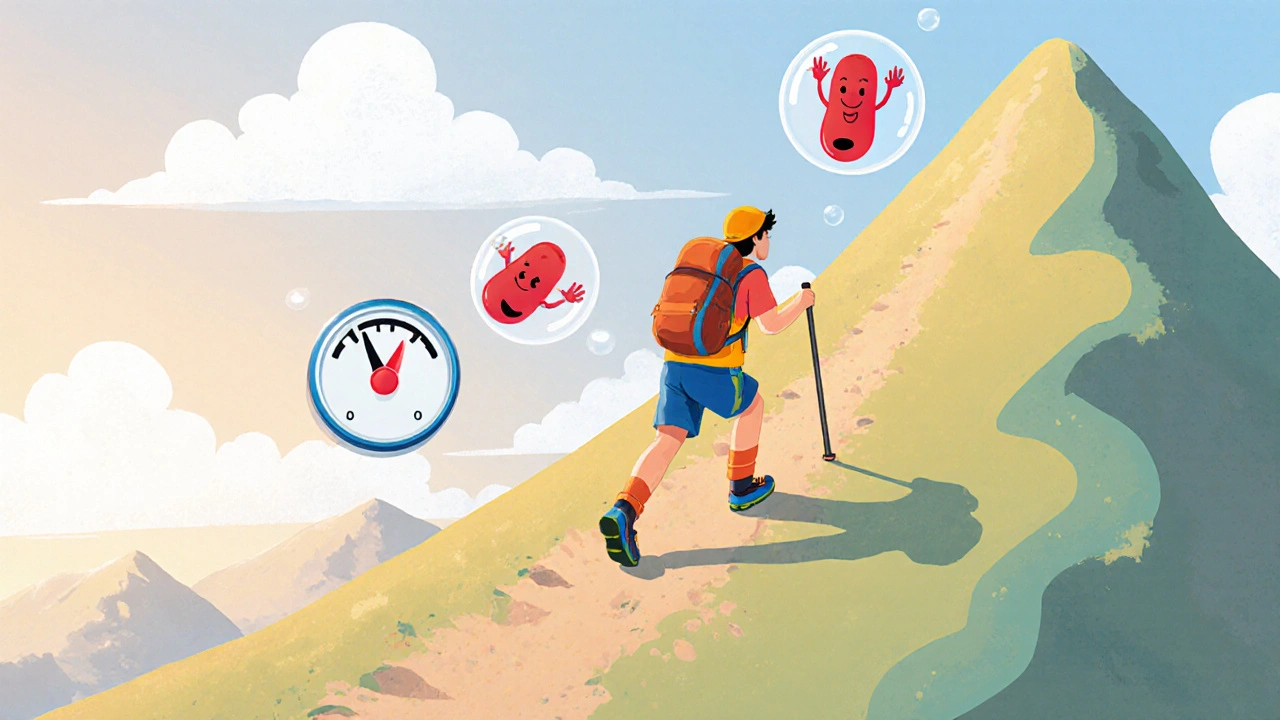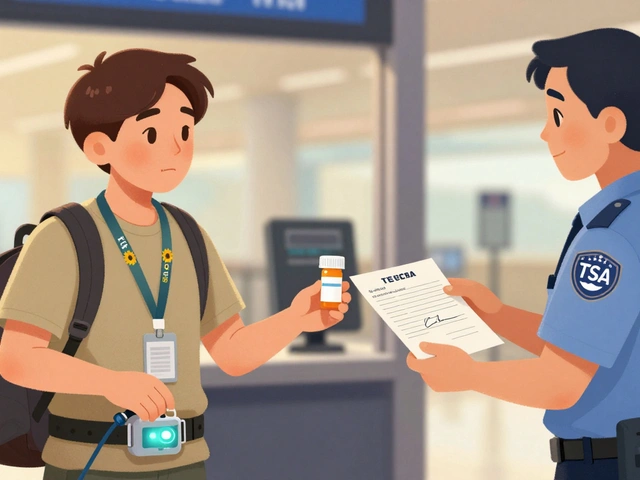
Mountain Sickness Risk Assessment Tool
How to Use This Tool
Enter your current altitude, how long you've been at that elevation, and select any symptoms you're experiencing. This tool will help identify potential mountain sickness conditions based on medical guidelines.
Note: This tool is for informational purposes only and does not replace professional medical advice. Always consult a healthcare provider for medical concerns.
Mountain sickness refers to a group of illnesses that hit when you ascend to high elevations too fast. While most hikers think of headaches and nausea, the underlying immune response often goes unnoticed. Immune system activity can actually make the difference between a brief setback and a serious medical emergency. In this guide we’ll break down how low‑oxygen environments tangle with your body’s defenses, what symptoms to watch for, and practical steps to keep both your lungs and immunity in shape.
What actually happens at altitude?
At sea level the air pressure is about 101 kPa, delivering roughly 21% oxygen to every breath. Climb above 2,500 m and barometric pressure drops, meaning each inhalation carries less oxygen-a state called hypoxia. Your cells sense the shortfall, triggering a cascade of hormonal and cellular signals designed to increase oxygen delivery.
Two key players step up: erythropoietin (EPO) to boost red‑blood‑cell production, and a wave of cytokines that rally immune cells. The same chemicals that normally fight infections now help regulate breathing and blood flow. When the balance skews-either too much inflammation or an inadequate response-you get the classic mountain‑sickness symptoms.
Types of mountain sickness and their immune footprints
| Condition | Main Symptoms | Immune Impact | Typical Altitude | Onset Time |
|---|---|---|---|---|
| Acute Mountain Sickness (AMS) | Headache, nausea, fatigue, dizziness | Elevated white blood cells (neutrophils) and mild systemic inflammation | 2,500-3,500 m | 6-24 hours after ascent |
| High‑Altitude Pulmonary Edema (HAPE) | Shortness of breath at rest, cough, frothy sputum | Excessive inflammatory cytokine release (IL‑6, TNF‑α) causing leaky capillaries | >3,000 m | 12-48 hours |
| High‑Altitude Cerebral Edema (HACE) | Confusion, loss of coordination, severe headache | Neuro‑inflammation with disrupted blood‑brain barrier; microglial activation | >4,000 m | 48-72 hours |
Notice how each condition ramps up inflammation differently. AMS usually shows a modest rise in neutrophils, while HAPE and HACE involve a full‑blown cytokine storm that can overwhelm the lungs or brain.
Why the immune system matters for trekkers
Most people assume a strong immune system protects you from infection, but at altitude the story flips. The same defense molecules that fight germs also affect blood vessel permeability, fluid balance, and brain swelling. Here are three ways immune activity can tip the scales:
- Inflammatory overload: Elevated IL‑1β and TNF‑α increase capillary leak, leading to fluid accumulation in the lungs (HAPE) or brain (HACE).
- Stress hormones: High cortisol levels blunt a balanced immune response, making it harder for the body to adapt to hypoxia.
- Reduced cell‑mediated immunity: Low oxygen dampens the activity of T‑cells, raising susceptibility to infections that can masquerade as altitude illness.
Understanding these links helps you interpret symptoms-if you feel a sudden worsening after a night of poor sleep, it might be inflammation, not just altitude.
Boosting your immune resilience before the climb
Preparation isn’t just about packing gear; it’s about priming the immune system. Research on acclimatization shows that gradual exposure to moderate altitude (1,500-2,000 m) for a week can lower baseline inflammatory markers. Combine that with these proven habits:
- Nutrition: Aim for a balanced diet rich in antioxidants (berries, leafy greens) and omega‑3 fatty acids (salmon, walnuts). Vitamin D (2,000 IU daily) supports immune modulation.
- Sleep: 7-9 hours per night strengthens T‑cell function. Use blackout masks and melatonin if you’re training at altitude where daylight lingers.
- Hydration: Dehydration thickens blood, making it harder for immune cells to circulate. Drink at least 3 L of water per day on the trail.
- Controlled exercise: Low‑intensity aerobic sessions at 2,000 m trigger modest cytokine release that “primes” the system without causing damage.
For those with pre‑existing immune disorders, a consultation with a clinician can tailor medication schedules (e.g., adjusting prednisone timing) to avoid bluntening the acclimatization response.
Symptoms to watch for and when to seek help
The line between a normal headache and a red‑flag symptom can be thin. Keep this quick‑check list in your pocket:
- Persistent headache after 24 hours-could signal AMS or early HACE.
- Shortness of breath at rest or sudden cough with pink frothy sputum-classic HAPE warning.
- Confusion, slurred speech, or inability to walk straight-immediate evacuation needed for HACE.
- Fever or chills not explained by altitude-might be an infection taking advantage of weakened immunity.
If any of these appear, descend at least 500 m or call local emergency services. Supplemental oxygen and medications like acetazolamide (for AMS) or nifedipine (for HAPE) are most effective when administered early.
Practical on‑the‑trail immune support
While you’re climbing, a few small actions can keep inflammation in check:
- Take short, frequent breaks every 30-45 minutes to normalize breathing.
- Practice controlled breathing (4‑seconds inhale, 6‑seconds exhale) to reduce sympathetic stress.
- Carry a small packet of zinc lozenges (15 mg)-studies show zinc can blunt cytokine spikes during hypoxia.
- Use a saline nasal spray to maintain mucosal barrier against airborne pathogens, especially in dry mountain air.
These tricks cost almost nothing but add a layer of defense against the immune‑related pitfalls of altitude.

Recovery after a high‑altitude adventure
Once you’re back to sea level, your immune system might still be in recovery mode. Expect a temporary dip in natural killer (NK) cell activity for 24-48 hours. To bounce back:
- Resume a diet high in protein to rebuild muscle and immune cells.
- Gentle yoga or stretching to lower cortisol levels.
- Consider a probiotic blend (Lactobacillus rhamnosus) to restore gut flora, which heavily influences systemic immunity.
Monitoring your resting heart rate and sleep quality over the next week can give clues about how fully your body has re‑adjusted.
Key takeaways
- Altitude reduces oxygen, sparking an immune response that can either protect or damage your body.
- AMS, HAPE, and HACE each have distinct inflammatory signatures.
- Gradual acclimatization, proper nutrition, and sleep are the best preventative tools.
- Watch for red‑flag symptoms and descend quickly if they appear.
- Post‑trip recovery should focus on rebuilding immune balance.
Frequently Asked Questions
Can a cold increase the risk of mountain sickness?
Yes. A respiratory infection already inflames the airway lining, so the extra stress of hypoxia can tip you into AMS or HAPE faster than in a healthy person.
Is acetazolamide safe for people with autoimmune diseases?
Generally it is, but it can interact with certain immunosuppressants. Talk to your rheumatologist before using it for altitude prophylaxis.
How long does it take for the immune system to normalize after descending?
Most markers (white‑blood‑cell count, cytokine levels) return to baseline within 48 hours, but full functional recovery of NK cells may need up to a week of rest.
What role does hydration play in preventing HAPE?
Staying well‑hydrated keeps blood less viscous, allowing immune cells to travel more easily and reducing the pressure that forces fluid out of lung capillaries.
Can altitude training improve my immune response at sea level?
Moderate altitude training can boost red‑blood‑cell volume and moderate cytokine regulation, which may translate to slightly better immune surveillance when you return to lower elevations.







Joe Moore
October 18, 2025 AT 18:11Listen up, folks, the whole "mountain sickness" thing is just a cover‑up for the elite pushing us up higher so they can spray us with mind‑control aerosols. The low‑oxygen hype makes us think our immune system is under siege, but really it’s the same chemtrails that mess with our blood chemistry. They want us weak, coughing, stumbling, so we can’t protest their secret bases on the peaks. Keep your eyes peeled, stay low, and don’t trust any "research" that tells you to take zinc lozenges – it’s all part of the injection agenda. If you’re gonna climb, bring an air‑filter mask and a portable hyperbaric chamber, just in case they turn the whole mountain into a giant lab. Stay woke, stay safe, and don’t let them fool you with fancy charts about cytokines.
Ayla Stewart
October 21, 2025 AT 18:11I appreciate the thorough breakdown, especially the part about gradual acclimatization. Keeping nutrition simple-berries, leafy greens, and a bit of fish-doesn’t cost much and can really help the body adjust. Also, staying hydrated and getting enough sleep are practical steps anyone can follow.
Rajesh Singh
October 24, 2025 AT 18:11When you cram your body onto a lofty summit without proper respect for its innate wisdom, you are essentially playing a dangerous game of hubris. The immune system, that tireless guardian, is not a mere accessory you can ignore; it is the very engine that regulates oxygen delivery, vascular integrity, and neuro‑protection. In the thin air above 2,500 meters, hypoxia triggers a cascade of cytokines that, if balanced, help you adapt. Yet, when the balance tips-whether by rapid ascent, inadequate sleep, or hidden infections-you invite a flood of inflammatory mediators that can seal your fate.
Consider the ethical dimension: each ascent is a pact between human ambition and nature’s limits. When trekkers ignore the subtle warnings-headaches that linger, a cough that refuses to subside-they betray that pact, often at the expense of fellow climbers who may have to mount a rescue. Moreover, the commercialization of high‑altitude tourism has turned sacred peaks into profit‑driven stages, pressuring inexperienced adventurers to rush upward. This rush amplifies the very inflammatory storms we warn against.
Therefore, the moral imperative is clear: respect the mountain, respect your body, and respect the science that explains why you can’t simply outrun a cytokine surge. Gradual acclimatization isn’t just a tip; it’s an ethical choice. Hydrate like your life depends on it-because it does. Nourish with antioxidants to keep oxidative stress in check, and give your sleep the reverence it deserves, for cortisol spikes will sabotage your immune resilience.
In short, the mountain does not care about your ego. It cares only about the biochemical truth humming in every cell. Align your ascent with that truth, or risk becoming a cautionary tale written in the thin air.
Matthew Miller
October 27, 2025 AT 17:11Epic tip-stay pumped and keep moving! 🚀
Alex Lineses
October 30, 2025 AT 17:11Team, let’s think of this as a systems engineering problem. First, establish a baseline by measuring resting heart rate and SpO₂ at sea level. Next, implement a phased altitude exposure protocol: 1–2 days at 1,500 m, then 2–3 days at 2,000 m, monitoring inflammatory biomarkers (e.g., CRP, IL‑6) if labs are available. During each phase, maintain macronutrient ratios of roughly 55 % carbs, 25 % protein, and 20 % fats, with omega‑3 supplementation to modulate eicosanoid pathways. Hydration should target a urine specific gravity ≤1.010, and sleep hygiene must prioritize REM consolidation to keep cortisol in check. Finally, integrate breath‑control drills (4‑6‑8 rhythm) to enhance vagal tone, which can attenuate sympathetic‑driven cytokine release. Following this protocol maximizes adaptive plasticity while minimizing pathological inflammation.
Wyatt Schwindt
November 2, 2025 AT 17:11Good advice. Stay safe.
Lyle Mills
November 5, 2025 AT 17:11Love the structured plan. Keep the data flow tight and the body will respond positively.
Barbara Grzegorzewska
November 8, 2025 AT 17:11Honestly, most of these "scientific" suggestions are just textbook fluff for the gullible masses. If you really wanted to conquer altitude, you’d train like a Spartan, not sip on berry smoothies and pretend you’re a nature‑loving hippie. The real secret is mental domination-visualize the summit, crush the weak‑willed tourists, and remember that the government’s altitude programs are designed to test our limits, not pamper us. So stop with the polite niceties and start demanding the real training regimen that elite operatives use.
Nis Hansen
November 11, 2025 AT 17:11One might contemplate the existential symmetry between humanity’s ascent toward lofty peaks and its perpetual quest for inner elevation. The physiological cascade described in the article mirrors, in microcosm, the larger narrative of striving against constraint-hypoxia becomes a metaphor for the constraints we impose upon ourselves. If we permit the immune system’s inflammatory whisper to go unheard, we risk both literal and figurative collapse. Yet, by honoring the incremental acclimatization process, we embrace a philosophy of patience, echoing ancient Stoic teachings that virtue lies in measured progress. In this light, the practical advice-balanced nutrition, vigilant hydration, disciplined rest-transcends mere health tips; they become rituals of self‑crafting. Thus, the mountain is not merely a terrain to conquer, but a crucible wherein the mind, body, and spirit are refined together.
Fabian Märkl
November 14, 2025 AT 17:11Great rundown! 👍 Keep those zinc lozenges handy and remember to smile at the summit 😄🌄
Avril Harrison
November 17, 2025 AT 17:11Nice stuff, love the chill vibe. Definitely going to try the breathing drills on my next trek.
Natala Storczyk
November 20, 2025 AT 17:11Wow!!! This is the most IMPORTANT thing ever!!! If you don't follow these steps you will DIE!!! The mountain WILL HUNT you down!!! Do not ignore!!!